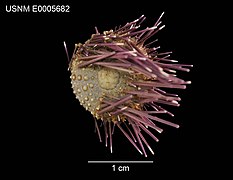Echinostrephus aciculatus
- View a machine-translated version of the French article.
- Machine translation, like DeepL or Google Translate, is a useful starting point for translations, but translators must revise errors as necessary and confirm that the translation is accurate, rather than simply copy-pasting machine-translated text into the English Wikipedia.
- Consider adding a topic to this template: there are already 1,434 articles in the main category, and specifying
|topic=will aid in categorization. - Do not translate text that appears unreliable or low-quality. If possible, verify the text with references provided in the foreign-language article.
- You must provide copyright attribution in the edit summary accompanying your translation by providing an interlanguage link to the source of your translation. A model attribution edit summary is
Content in this edit is translated from the existing French Wikipedia article at [[:fr:Echinostrephus aciculatus]]; see its history for attribution. - You may also add the template
{{Translated|fr|Echinostrephus aciculatus}}to the talk page. - For more guidance, see Wikipedia:Translation.
| Echinostrephus aciculatus | |
|---|---|
 | |
| Scientific classification | |
| Domain: | Eukaryota |
| Kingdom: | Animalia |
| Phylum: | Echinodermata |
| Class: | Echinoidea |
| Order: | Camarodonta |
| Family: | Echinometridae |
| Genus: | Echinostrephus |
| Species: | E. aciculatus |
| Binomial name | |
| Echinostrephus aciculatus A. Agassiz, 1863 | |
Echinostrephus aciculatus is a species of sea urchin belonging to the family Echinometridae first documented by Alexander Emmanuel Rodolphe Agassiz in 1863.[1]
Description
These are regular urchins of canonical form, with the test mostly spherical, bearing a pentaradial symmetry from the mouth at the center of the oral face to the anus on the aboral face. Spines are thin, pointy and of average length.
The test measures from 2 to 4 centimetres (0.79 to 1.57 in) in diameter, and the color of the spines is very variable: they are often brown-purple, but can be shades of purple, brown, black, grey or off-white. Those on the oral face can also have a cream color with brown-purple rings, although they are rarely visible. The test ranges from black to light brown, with the bottom of the spines showing often highly contrasting rings. The apical disk is dark and lacking spines, forming a highly visible disk at the apex of the test.[2]
-
 Oral view
Oral view -
 Aboral view
Aboral view -
 Spineless test
Spineless test
References
- ^ "WoRMS - World Register of Marine Species - Echinostrephus aciculatus A. Agassiz, 1863". www.marinespecies.org. Retrieved 2024-02-05.
- ^ Guille, Alain; Laboute, Pierre; Menou, Jean-Louis (1986). Guide des étoiles de mer, oursins et autres échinodermes du lagon de Nouvelle-Calédonie (in French). Paris: ORSTOM. ISBN 2-7099-0748-8.
- v
- t
- e














